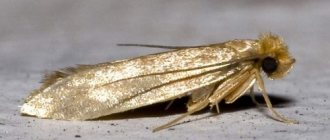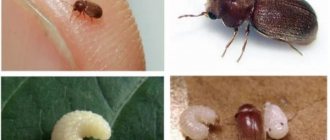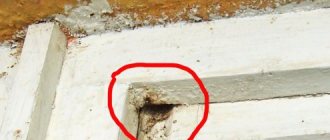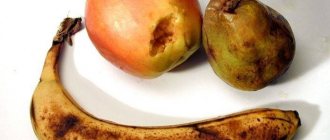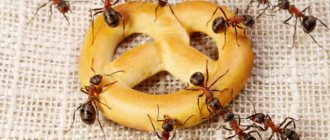Many housewives want to know how to get rid of bugs in cereals in the cupboard. The main reasons for the appearance of insects are improper organization of food storage, poor quality of raw materials or poor packaging. At the same time, some types of pests can spoil not only food, but also furniture, kitchen utensils, and towels.
Small bugs in cereals spoil the product and make it unfit for consumption. To get rid of the problem, it is necessary to eliminate its source, conduct an inventory audit and disinfect the premises
In this article, we have collected useful tips and recommendations that will help get rid of pests and also prevent their occurrence in the future.
Reasons for the appearance of bugs in cereals and flour
Several types of pests can be found on shelves and cabinets with bulk products:
- Surinamese flour beetle, or flour beetle. Dark brown or almost black insects easily chew through paper, cardboard and polyethylene. Bugs infest in flour and starch, but do not disdain cereals, tea, noodles, breadcrumbs, nuts and hot spices.
- Bread grinder. Light brown bugs infect bread, cereals, grain mixtures, dry food for cats and dogs, tea leaves, and dried medicinal plants.
- Red flour eater. Rusty-yellow bugs live in mills and bakeries. They feed on any bulk foods.
Insects do not fly in from the street and do not crawl from neighbors. They enter the house along with products purchased at the store. If manufacturers do not carry out special pre-sale processing of the product, eggs, larvae or adult pests may end up in bags of rice, buckwheat or pearl barley. Infection can occur during delivery at a point of sale, storage in a warehouse or supermarket. Food pests are distinguished by their fertility, unpretentiousness and vitality; they multiply quickly at high air humidity and room temperature.
Types of pests
It is not easy to find out that bugs have appeared in food. The development of the colony takes place inside the food substrate, and only when their numbers become too large, they go outside in search of a new place of distribution. If there are bugs in the cereal, you can get rid of uninvited guests only by understanding what species they are and what danger they pose.
Bread grinder
These small bugs, 1.7-3.8 mm in size, can be recognized by the rich brown color of their backs and their ability to fly.
They are afraid of light and are often located between the frames of old wooden windows.
Bugs live mainly in cereals, baked goods, stocks of medicinal herbs, and “love” tea and coffee.
Larvae are more dangerous than adults, as they are gluttonous and indiscriminate in their eating.
Khrushchak or flour beetle
These bugs can be small and large, measuring 3-4 and 12-16 mm, respectively.
They are black or brown in color and emit an extremely unpleasant odor.
They are highly fertile and live in rice, semolina, buckwheat, rolled oats, flour and starch.
Red mukoed
It has an orange-rusty color and a body densely covered with hairs, 1.5-2.5 mm in size. Settles in various cereals and flour.
food moth
The closest relative of the clothing moth, it is distinguished by its fluffy body, the presence of antennae and wings with a fringe along the edge.
The butterfly itself is practically not interested in food supplies in the kitchen; the larvae are voracious, eating everything they find on their way: cereals, pasta, dried fruits, tea. It is not easy to deal with them, since they easily deal with plastic packaging and get to the products.
Bean grain
The bug is easily recognized by its brown oval body, its size ranges from 2-4 mm.
Bean lovers are less likely to be found in peas, chickpeas, lentils and soybeans.
Rice weevil
The most common type of pest. It reproduces very quickly and flies well. Thanks to its well-developed oral apparatus, it is able to cope with any grain, despite the fact that it is barely 2 mm in length.
Most often it appears in the summer, since the reproduction process requires an increase in temperature to 26-30°C.
Sources of appearance
Many housewives wonder where midges come from in their apartments. Most often, insects appear in summer or autumn, but they can also appear in winter, even in a room with tightly closed windows and doors. Therefore, before you start fighting them, you need to find the source of their occurrence:
- Contaminated and slightly rotten fruits brought into the house from a store or garden are the most common cause of midges appearing in the kitchen. They create ideal conditions for insects to feed and reproduce. Midges are especially common on the balcony in the fall, where a lot of vegetables are stored for canning. To get rid of it, you need to destroy the missing products.
- Poor trash bin hygiene and irregular waste disposal may also be a precursor to the appearance of fruit flies in the kitchen. Despite the fact that the lifespan of insects is only a day, they manage to lay eggs in rotting food waste. As a result, you have to look for ways to get rid of midges in your apartment.
- Failure to clean your pet's cage in a timely manner can also cause midges to appear in your apartment. An unkempt dog or cat bowl, a dirty aquarium and rotting algae in it are excellent sources for the spread of insects. Regular cleaning of your pet's dishes will help get rid of pests in your home.
- Midges in the house can start in the soil of indoor plants. Excessively abundant watering and fertilization with used tea leaves create favorable conditions for the proliferation of flower midges on windows.
- The cause of midges in the kitchen may be a clogged drain. Food particles stuck in the siphon continue to decompose there, which provokes the emergence of new individuals. In such a situation, cleaning the siphon with a special product will help get rid of insects.
- Faulty plumbing can also contribute to the presence of midges in the kitchen. A constant leaking faucet creates dampness in the apartment, which insects love so much.
- Insects can enter the kitchen through the vents or simply fly into the house from the street through a window or door.
Ways to get rid of bugs
To get rid of bugs, it is necessary to carry out a whole range of measures to destroy not only them themselves, but also their offspring, waste products. And first of all, this is, of course, to carry out high-quality cleaning. Armed with rags and sponges, you will have to open all the kitchen cabinets and empty and treat all the shelves and drawers.
We recommend: How to wash linoleum at home for shine: tools, household and folk remedies
It is necessary to carefully sweep away any remaining grains that may have spilled and simply wipe everything with a dry or slightly damp cloth. After this you can proceed to processing:
- Table vinegar works well not only with adults
, but also their larvae and eggs.
- Therefore, you need to dilute 9% vinegar approximately 1:1 with plain water and wipe all surfaces with this solution. And not only the horizontal shelves themselves, but also the vertical ones, including the doors.
- Particular attention should be paid to the joints. If your furniture allows it (not varnished), you can pour the solution into a spray bottle and spray hard-to-reach joints, for example, in the area of hinges on doors.
- Then dry the furniture thoroughly so that it does not get wet or deteriorate.
- Soda-salt solution can be used instead of vinegar. Dissolve a couple of tablespoons of ordinary rock salt and a spoonful of baking soda in a liter of warm water, stir well, the solution is ready.
Now let's move on to storage containers:
- If you choose glass or plastic containers for storage , then you need to not only wash them, but also thoroughly pour boiling water over them, which will kill the bug eggs.
- If you store cereals in fabric bags , then they should not only be washed, but also boiled.
- It’s better not to do anything with plastic bags , but simply throw them away and immediately into the garbage disposal, and not into the trash can in the kitchen, from where the parasites will quickly crawl back out.
After the main shelters of the bugs have been eliminated and processed, it is worth moving on to the remaining items. It is advisable to wipe everything with vinegar solutions: refrigerator, microwave and other appliances and furniture:
- Pyrethrum helps well; it is a flower powder that is made from Caucasian chamomile, absolutely organic and safe for humans and pets. It should be sprayed carefully in cabinets. To do this, you can simply pour a little onto a dry palm and blow gently in the direction of the shelf you need. Make sure that the powder gets into the cracks and joints.
- If your pest is a food moth, then in addition to the procedures described above, it is necessary to add treatment with any chemical agent for ordinary moths. Moreover, you also need to spray carpets, rugs, and upholstered furniture, if any.
If you choose glass or plastic containers for storage, then you need to not only wash them, but also thoroughly rinse them with boiling water, which will kill the bug eggs
What chemicals should I use to remove it?
Store shelves are replete with various anti-fly products. Their disadvantage is their synthetic composition, which often leads to allergic reactions in households. It is advisable to avoid negative consequences by leaving the room during the midge treatment period. Popular remedies for fruit midges are: “Raptor”, “Aerokson”. It is good to pester the potted midge with Aktara or Grom-2.
An excellent alternative to store-bought chemicals are homemade traps, which almost anyone can make. You do not need any special skills to do this, and they will not harm your family members.
Methods for getting rid of black bugs in the kitchen
If you find bugs in the kitchen, take the necessary measures to destroy them:
- Identify and correct the source of the problem. Empty the cabinets and review all supplies of cereals, flour, dried fruits, tablets, tea and coffee. Place spoiled food in a bag and place it in the trash.
- Inspect the kitchen furniture, window sill and household appliances - sometimes uninvited guests are found in such unusual places.
- Wash food storage containers with soda solution.
- Wipe the doors and shelves of cabinets in the kitchen with a cloth soaked in a solution of vinegar (1 tablespoon per 1 liter of water) or detergent.
- Seal or seal any cracks that are discovered during cleaning.
- Pack the remaining intact cereals in an airtight glass container and take them outside the kitchen for 10-14 days. If no insects appear in them during this time, they can be eaten.
A prerequisite for getting rid of bugs in cereals is to thoroughly treat cabinets, shelves and other surfaces in the kitchen with a vinegar solution. This disinfection is safe for humans, but effectively repels pests.
Products that could be contaminated with parasites are subject to special treatment. The following methods are used for this purpose:
- exposure to ultraviolet radiation;
- exposure at high temperatures in the oven (10 minutes at a temperature of +100…120 ℃);
- exposure to low temperatures during the day (in the freezer).
Folk ways to fight bugs
To combat bugs in the kitchen, products with a bright aroma are used. Pests are repelled by the smell of bay leaves, lavender, garlic, wormwood, borax, vinegar and nutmeg. To get rid of pests, place any of them on the shelves of the closet and do not forget to change them periodically.
Traps that you can make at home will help you get rid of pests:
- Combine borax and powdered sugar in equal proportions.
- Pour the mixture into the lid and place the trap near the pest habitat.
- Check the bait regularly and refill it if necessary.
Bay leaf is an affordable, safe and effective means of repelling insects from cereals, tea, dried fruits and other food products.
Chemicals in pest control
When folk remedies do not help cope with pests, perform chemical treatment of the room. The method is used in exceptional cases with large-scale damage.
When using chemicals, observe safety rules and follow the instructions for use indicated on the packaging. Avoid contact of active substances with skin, eyes, respiratory organs and food. Carry out the treatment when there are no children or pets in the room, and after disinfection, ventilate the kitchen well.
Treating cabinets with chlorine-containing products (Domestos, Belizna, etc.) will help you deal with bugs in the kitchen. Wipe all shelves, walls, cabinet doors and leave the room to ventilate for a couple of hours. After a day, repeat the treatment.
Other means to combat bugs in cereals and in the kitchen:
- pyrethrum powder. Sprinkle the product where you store food and after a couple of days you will forget about pests. The insecticide is safe for pets and people;
- "Lovin Fire Protection". An effective poison for flour eaters and bread grinders. When using the product, wear a respirator, as its fumes are dangerous to humans;
- "Anti-bug." Treat wooden surfaces with a special protective agent - it will not only get rid of pests, but also prevent their occurrence in the future. Be careful when working with the product, as it is dangerous if it comes into contact with the skin or mucous membranes;
- "Rogneda". The drugs of this brand are effective in combating various pests - bugs, ants, flies, fruit flies, cockroaches.
Wild chamomile (pyrethrum) repels pests with its aroma. Place a small bouquet or bag of powder on the kitchen shelves and you don’t have to worry about your cereal supplies
According to consumer reviews, proven Dichlorvos will help remove bugs forever. Procedure for using the aerosol:
- Hide all food products and throw away spoiled products.
- Wash cereal containers and all kitchen cabinets.
- Make sure there are no pets or children in the room. Take personal safety measures - wear a respirator or bandage.
- Spray the room with an aerosol and close the kitchen for half an hour. Then turn on the hood and open the window to ventilate the apartment well.
After treating the room with chemicals, vacuum all shelves and floors, as there may be dead cereal pests lying on them.
How to get rid of bugs using folk remedies
If there are bugs in rice, buckwheat, flour or pasta, you can use effective folk recipes.
Salt
Fabric bags, soaked in a strong saline solution and dried without subsequent rinsing in clean water, are the best storage place for flour and cereals. Insects will never appear in such a salted container.
Table vinegar
A vinegar solution made from equal parts of water and table vinegar (9%!) will help clean the external and internal surfaces of kitchen cabinets where kitchen utensils, bulk and confectionery products are stored.
Technology for treating furniture with vinegar:
- Empty the shelves, clean them of scattered grains and crumbs.
- Wipe all doors, horizontal and vertical surfaces with a water-vinegar solution.
- Pour the solution from a spray bottle into corners, joints and hard-to-reach places.
- Leave the doors open to help the furniture dry faster.
In the same way, you can use a solution prepared from 2 tbsp. l baking soda, 2 tbsp. l. table salt and 1 liter of warm water.
Strong scents: lavender
Midges will not appear in cereals if bulk supplies are stored in cloth bags soaked in water with the addition of lavender essential oil. The rich smell of this plant will not disappear from kitchen cabinets and pencil cases if you place cotton swabs soaked in an aromatic substance inside the furniture and periodically replace them with new ones.
Boric acid
Boric acid crystals are lethal to insects. If a pest tastes the bait with the powder, there is no doubt about its death. And particles brought to the nest on the legs and wings will become poison for other individuals.
To destroy insects in cereals or flour, you need to prepare a sweet bait:
- In a bowl, mix powdered sugar and boric acid (borax) in a 1:1 ratio.
- Pour bait into flat small bowls (lids) or square pieces of cardboard.
- Place the poison under kitchen furniture, inside cabinets, chests of drawers and pencil cases. Place the products in scalded and dried glass jars and seal them tightly.
Instead of powdered sugar, you can add old jam or melted honey to boric acid. As the top layer dries out, the liquid bait should be replaced with freshly prepared bait.
Grinder
There is another type of harmful bugs that appear in the kitchen. They are called Grinders (“Anobiidae” in Latin). Their head is shaped like a hood. Their body color ranges from dark yellow to brown. There are two types: brownie and bread.
In our cities, as a rule, there is a bread grinder. It is smaller in size than the brownie and, in addition to wood, feeds on bread and crackers.
It can also lay eggs in books. Let's figure out how to get rid of bugs in the kitchen.
How to fight
- Seal all the wooden cracks - the floor, the window sill, the cracks in the kitchen furniture, in general, everything you find.
- Seal the entire cereal hermetically. No bags, only dishes that are sealed tightly.
- They love sweets and carbohydrates. It is better to put all dried fruits in the refrigerator.
- Place borax on the shelves; you can buy it at the pharmacy. But spraying with various chemicals is not the best solution.
If there are bugs in the cereal, this is not a sign of poor quality cleaning in the residential area. The bug appears for other reasons. To effectively combat it, you need to follow a number of simple recommendations. Preventive measures will help get rid of insects in cereals, preventing severe infestation.
The main factor that leads to the emergence of pests in flour and cereals is low quality and the complete lack of heat treatment or insufficiently high temperatures during this process. Another reason is violation of storage conditions for flour and cereal products. Because of this, beetles are found in rice or semolina, and in sealed packages.
Things are much simpler with loose products. At the same time, bugs appear in cereals more often, since they are close to contaminated flour. In the kitchen, insects switch to clean food as a result of loose lids on storage containers. Bugs can appear even if you purchase clean cereals, however, if you borrow even a small amount of contaminated flour, rice, or buckwheat from your neighbors, it is highly likely that the insects will now spread to other products in the kitchen.
If you find some bugs in flour: you need to determine their type as quickly as possible and begin eliminating them
Moreover, pests choose not only cereals, but also dried fruits, tea, coffee, and spices to infest. Most dry foods become contaminated using the methods described above. If there are bugs in the cereal, they are difficult to notice due to their very small size, especially when the dry product is dark in color and has large fractions.
What to do if there are bugs?
First of all, check all the products. Most often, housewives remember flour and cereals, but insects can hide in other places.
Where to look for bugs?
Bugs are nosy and almost omnivorous insects. Therefore, if you catch your eye at least one, you need to urgently organize an audit and look for them in all sorts of “hiding places”:
- beans - favorite habitat;
- bread;
- flour and cereals;
- dried fruits;
- spices (they even live in pepper bags);
- vegetables (soft rotting onions are a reason to take a closer look);
- tea and coffee;
- cookie;
- cracks in furniture and window sills;
- kitchen appliances;
- first aid kit (bugs are susceptible to mustard plasters).
After a thorough home inspection, you need to do the following:
- If few insects are found, some of the products can be saved by calcining them in the oven or keeping them in the freezer for a day (then the flour or cereal must be sifted through a sieve). Heavily contaminated supplies will have to be disposed of.
Legumes need to be immersed in salt water and wait until the beetles and their offspring float to the surface, after which the water should be drained and the grains dried.
The garbage along with the bugs must be taken out immediately before they crawl into the cracks of the floor.
- Place unaffected products into glass jars and close tightly.
- Clear the cabinets of food and rinse with vinegar water (1 teaspoon per liter).
- Disinfect all rooms to prevent insects from breeding. Pouring boiling water into the cracks (for wooden floors) gives good results.
The main thing is to make sure that all insect habitats are declassified.
Traditional methods of fighting bugs
The problem of getting rid of cereal bugs appeared from the moment people began to stockpile, which is why you can find many recipes in folk councils.
Vinegar
Vinegar can be used to get rid of insects and to prevent their occurrence. The beauty of the method is that it is effective not only against adults, but also against larvae.
To get rid of bugs, vinegar (9%!) is diluted in equal amounts with water and treated all horizontal and vertical surfaces of cabinets, inside and out. And don't forget about the door treatment.
Walk along the joints with special care. If the furniture is not varnished, put the solution in a container with a spray bottle and spray hard-to-reach areas. Be sure to let the furniture dry.
For prophylaxis, the solution is used in a similar way. But it is prepared from 1 liter of water and 2 tbsp. l. vinegar.
Borax + sugar
Sodium tetraborate, or in common parlance - borax, is the sodium salt of boric acid and belongs to the class of inorganic compounds. It has excellent performance indicators and allows you to get rid of kitchen insects for a long time.
To prepare the composition:
- Combine borax, granulated sugar and dry yeast in equal proportions. The last 2 components are designed to attract insects.
- Pass the mixture of ingredients through a coffee grinder to obtain a homogeneous flowing mass.
- Pour in small portions onto prepared sheets of paper or a napkin and place in the habitats of the bugs.
An alternative method: prepare bait from borax, millet and powdered sugar. Grind all components, taken in equal proportions, with a coffee grinder and roll into small balls (you can add a little water). Place them on the shelves of your kitchen cabinets. This method also effectively gets rid of uninvited guests, the main condition is to place the balls out of reach of children and pets.
Attention! The poison is laid out after the cabinets are thoroughly washed and disinfected.
Plants with a strong smell
Bugs do not like strong aromas; pyrethrum, cloves, bay leaves and wormwood have a detrimental effect on them. To get rid of food pests, pack dried plants in gauze bags, folded several times, and place them on the shelves of kitchen cabinets.
Preventive treatment of bulk products
Preventative measures at home will help protect against the appearance of unwanted insects in the house:
- When purchasing cereals and pasta, carefully inspect the packaging and its contents. If you have the slightest suspicion, refuse to purchase or opt for cereals from a well-known manufacturer.
- Use airtight containers (glass jars or plastic containers) for storage.
- Before pouring the cereal from the bag into a storage container, carefully examine it again and make sure there are no bugs.
- To prevent infection, place the cereal on a baking sheet and place in a preheated oven for 30–40 minutes. High temperatures kill insects and their larvae.
- The purchased cereal can be placed in the freezer for 24 hours and then packaged in airtight containers. This will also help get rid of beetle larvae.
- Don't make huge stocks. The recommended period for consuming cereals is no more than 2 months.
- Take inventory of your inventory regularly. If you have any doubts about the quality of the cereal, get rid of it.
- Keep cabinets and other food storage areas clean and organized.
- When buying dried fruits, rinse them, pour boiling water over them and store only in the refrigerator.
- Regular ventilation of the kitchen will help avoid high humidity and the appearance of certain types of pests.
Following these rules will prevent larger problems and preserve food.
How to prevent a new invasion?
There's no way you can prevent this. Little depends on cleanliness, but rather on attentiveness.
The only thing that can be recommended is to keep cereals in hermetically sealed glass jars, specially designed for storing bulk products (here is a good article on this topic).
Although this is not a panacea, at least then they won’t scatter to other places.
Also, be sure to close the packages with spices, even with regular paper clips.
In general, there is only one prevention: just try not to buy anything for future use. It’s probably not 1917, and you can go to the store at any time. It is better to buy less and a little more expensive than a lot, cheaply, but send half to feed the yard dogs.
Tips and tricks
- The main advice is, of course, cleanliness combined with a few little tricks.
- When buying cereal or flour, do not rush to immediately pour it into a jar and put it in the cupboard. It is better to put the bag in the freezer overnight, or even for a day. If the cereal is infected, then this, of course, will not get rid of the bugs. But at low temperatures they will die, like their larvae and eggs, which means they will not reproduce and move to your other reserves.
- Make it a rule when cleaning cabinets to wipe them with a vinegar or water-salt solution. Vinegar 9%! Dilute with water 1:1 or add a spoonful of regular baking soda and salt to 1 liter of water.
- Nutmeg is a very aromatic remedy. Grind the nut as much as possible on a grater or in a mortar and, to prevent it from scattering all over the surface, take a wide piece of tape and evenly spread the resulting nut powder in a thin layer onto its strips. Then shake off the excess from the strips and cut into the amount you need. Place these nutmeg strips of scotch tape in the boxes. An effective and pleasant means of preventing bugs. You can also sprinkle already ground nutmeg from bags onto the tape.
- Lavender is another fragrant and simple remedy. Simply place the dried herbs on the shelves.
We recommend: TOP 10 best window cleaners - review of 2020
Prevention: how to avoid infection
To protect your own products from infection by pests after disinfestation, you can take some safety measures. To do this, a number of preventive measures are used, the main one of which is being careful when buying cereals and flour in a store or at the market. At home, you also need to consider a number of rules that can protect products:
- for bulk products you need containers with tight lids;
- You can place garlic or bay leaves on the shelves;
- when wet cleaning, vinegar or ammonia is added to the water;
- regular ventilation will reduce humidity in the room;
- Large reserves of cereals, flour and pasta cannot be made.
The main problem of mucoeds living in industrial warehouses, bakeries, shops, apartments and private houses is the destruction of food supplies in a short period of time. Because of this harmful insect, in a week or a month the entire available supply of flour, cereals and other groceries in the kitchen or pantry can be destroyed, and prevention is the best method of protection.
Attention! The main product in which the flour eater starts is flour. It is better to store such supplies separately from other bulk materials, which will reduce the likelihood of the spread of insects.



